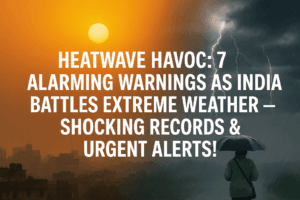Heatwave Havoc: 7 Alarming Warnings as India Battles Extreme Weather – Shocking Records & Urgent Alerts!
India is currently experiencing extreme and contrasting weather patterns, with northern and central regions scorched by a severe early-season heatwave, while the south and northeast brace for storms and heavy rainfall. Temperatures have soared past 40°C in many northern cities, with Barmer in Rajasthan hitting a record 46.4°C, well above seasonal norms. The India Meteorological Department (IMD) has issued multiple alerts, warning of severe heatwave conditions across Delhi, Gujarat, Madhya Pradesh, and Maharashtra.
In stark contrast, southern states like Tamil Nadu and Kerala are preparing for thunderstorms, strong winds, and lightning, driven by a developing cyclonic system over the Bay of Bengal. Hailstorms are also expected in Assam, Meghalaya, and Jharkhand. Delhi’s air quality remains poor, although slight improvements have been noted. Meteorologists attribute the intense heat to clear skies and stagnant winds, conditions likely to worsen in the coming days. As climate extremes intensify, experts stress the urgent need for public awareness, better preparedness, and stronger climate resilience across the country.

Heatwave Havoc: 7 Alarming Warnings as India Battles Extreme Weather – Shocking Records & Urgent Alerts!
As April unfolds, India is gripped by a striking weather divide. The northern and central regions are enduring an intense heatwave, while the southern and northeastern areas prepare for storms and heavy rains—highlighting the nation’s escalating climate challenges.
Scorching North: Record Temperatures and Health Alerts
Northern India is reeling under an unprecedented early summer, with temperatures soaring weeks ahead of schedule. The India Meteorological Department (IMD) has issued heatwave alerts for over seven states, including Delhi, Rajasthan, Gujarat, Punjab, Haryana, Uttar Pradesh, and Madhya Pradesh.
Delhi witnessed its first official heatwave of the season on April 8, with temperatures hitting 40.2°C—5°C above normal. The IMD predicts temperatures could rise to 42°C by April 10, prompting a yellow alert (caution) until then. Residents are advised to stay indoors, avoid peak sun hours, and stay hydrated.
Rajasthan’s Barmer district recorded a blistering 46.4°C, breaking its April record, while 27 western Indian cities surpassed 43°C. The IMD classifies a “severe heatwave” when temperatures exceed 45°C at multiple stations—a threshold already met in 19 locations.
The heatwave spans Rajasthan, Gujarat, Madhya Pradesh, Maharashtra, and Odisha, with Rajasthan under an orange alert (prepare for action) on April 8. Unusually warm nights are expected in Rajasthan, Madhya Pradesh, and coastal Gujarat, exacerbating discomfort. Humid conditions add to the misery along Maharashtra’s Konkan coast and in Goa.
Authorities urge vulnerable groups—children, the elderly, and those with health conditions—to limit outdoor activities, wear light clothing, and use protective gear like umbrellas. The early heat also threatens wheat crops, raising fears of a third consecutive year of agricultural losses.
Stormy South and Northeast: Cyclonic Systems Bring Relief and Risk
In contrast, southern states face turbulent weather. A cyclonic system over the Bay of Bengal is expected to trigger thunderstorms, heavy rains, and lightning in Tamil Nadu, Kerala, Karnataka, and Andhra Pradesh. While the rains may cool temperatures, they also bring risks like flash floods, strong winds, and lightning strikes.
The Northeast isn’t spared either. Assam, Meghalaya, and Jharkhand may experience hailstorms on April 8–9, potentially damaging crops and property. The IMD warns residents to stay alert despite the temporary respite from the heat.
Mumbai’s Humidity and Delhi’s Air Quality Struggles
Mumbai began April 9 with clear skies and a morning temperature of 31°C, but daytime highs of 35°C and 49% humidity made for sticky conditions. Similar weather is expected to persist. Meanwhile, Delhi’s air quality index (AQI) slightly improved to 216 (poor), though pollution levels may rise again until winds and cloud cover arrive later in the week to aid dispersion.
Experts Sound Alarm on Climate Trends
Meteorologists link the heatwave to calm winds and clear skies, which allow unchecked solar radiation to heat the ground. Mahesh Palawat of Skymet Weather warns, “Slower winds and clearer skies will push temperatures higher.” IMD Director-General Mrutyunjay Mohapatra also predicts a harsh summer, with states like Uttar Pradesh, Jharkhand, and Odisha expected to face 10–11 heatwave days—well above the seasonal average.
The early onset of extreme heat mirrors recent trends. In 2023, Rajasthan recorded an all-time high of 50.5°C and over 40,000 suspected heatstroke cases. These patterns underscore the urgency of climate adaptation.
A Nation at a Crossroads
India’s weather extremes reflect a growing climate crisis. The north battles life-threatening heat, while the south contends with destructive storms. These shifts demand robust infrastructure, public awareness campaigns, and sustainable farming practices to mitigate risks.
As citizens navigate these dual challenges, the IMD’s advisories remain critical: stay informed, prioritize safety, and support vulnerable communities. With experts flagging more frequent and intense weather events, India’s resilience is being tested like never before. The coming weeks will be a crucial indicator of how the nation adapts to its evolving climate reality.
You must be logged in to post a comment.